Content
Banana Giant onion is an early ripening garlic-onion hybrid that has a sweetish taste. The dietary product has a lot of medicinal properties. Cultivation of this variety does not require large expenses and does not cause difficulties even for novice gardeners.
Description of onion variety Banana Giant
The onion variety has several names, the most common among them being kushchevka and shallot. The hybrid owes its name to its resemblance to an exotic fruit, but unlike the banana, the Giant is not afraid of frost. Onions of this variety do not contain volatile compounds, so they do not hurt the eyes. Recommended for preparing salads, soups, and stir-fries.
Appearance
The Banana Giant bulb is quite large and elongated. The upper scales are golden in color, the inside of the fruit is white. The aerial part of the bush is made up of green feathers, the length of which reaches 35 cm. They are significantly superior in taste to other varieties.
Shallots grow in nests.Each can produce from 5 to 15 bulbs with an average weight of up to 100 g. The more bulbs in the family, the smaller they are.
Ripening time and yield
Banana Giant onion is an early ripening variety. In regions with a temperate climate, ripening occurs after 2.5 months. The oblong fruits grow up to 10 cm in height, the diameter of the vegetable is 2.5 cm. The weight of the bulb is from 70 to 170 g.
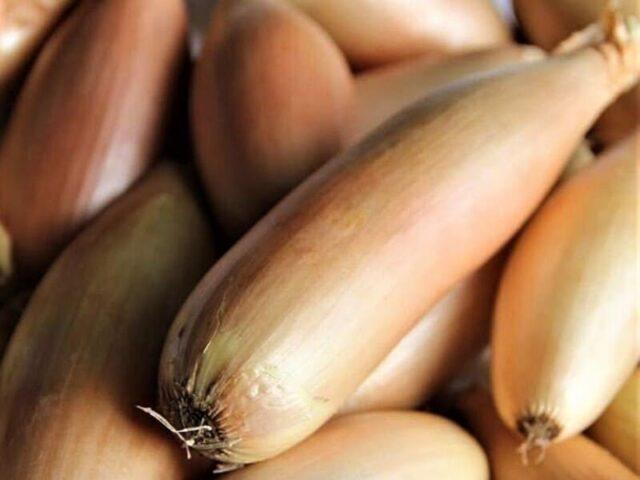
Yields of the Banana Giant hybrid per 1 hectare range from 12 to 25 tons
Growing regions
The hybrid was cultivated in European countries, India, Egypt and Greece. The golden giant has gained popularity in Russia and the former CIS countries.
Benefits and harms
Compared to other onions, Banana Shallot is a champion in terms of beneficial and nutrient content. There are more vitamins and mineral trace elements in the hybrid than in the onion variety. Family Giant is considered an excellent preventative.
Useful properties of golden onions:
- has a wound healing effect;
- improves brain activity;
- strengthens the eye muscles;
- normalizes blood pressure, thins the blood;
- increases the body's resistance to colds and viral diseases;
- improves the functioning of the gastrointestinal tract and cardiovascular system.
Those who have liver and kidney diseases should reduce their consumption of Giant Banana. People suffering from high acidity of the gastrointestinal tract should limit their consumption of vegetables.
Advantages and disadvantages
The advantages of the Banana Giant variety include:
- ease of care;
- high productivity;
- early ripeness;
- frost resistance, possibility of winter sowing;
- excellent taste;
- versatility of application;
- high concentration of vitamins and microelements;
- unlike other hybrids, there is no need to buy planting material annually.
No deficiencies have been identified in onions.
Landing dates
Banana Giant is a frost-resistant variety, but it is recommended to plant it in the spring, when the soil has warmed up well. For example, if you plant onions at the end of March (beginning of April), you will be able to enjoy the juicy green feathers already in May. Kushchevka will ripen by the end of June.
Planting shallots Banana Giant
For planting heirloom onions, you should choose an area that is well-warmed by the sun's rays. The soil should be fertile, loose, acidity level - 6.5-7 pH. If groundwater lies close to the surface, it is necessary to equip a drainage system.
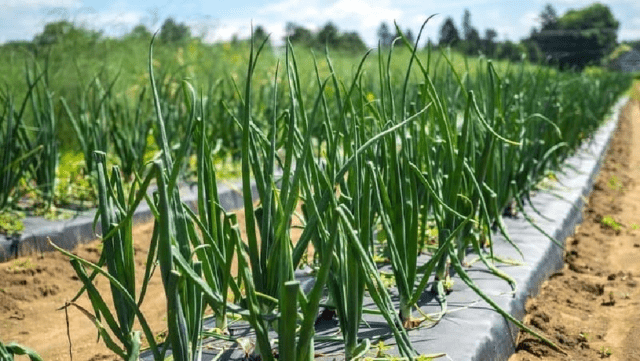
Shallot Banana Giant must be alternated with legumes
Cabbage, potatoes, tomatoes, zucchini and cucumbers are considered good predecessors. It is not recommended to grow heirloom onions next to onions, as they can cross-pollinate.
Growing Banana Giant onions from seeds
Prolonged propagation by vegetative means leads to a decrease in yield, the appearance of diseases, and shredding of the bulbs. To update the variety, once every few years they resort to growing a hybrid from seeds.
Seeds sown in the spring will produce onion sets for the fall, which will delight you with a rich harvest next season.
Planting sets
For cultivation, medium-sized bushes are selected (large ones will produce many small bulbs, and small ones will produce unproductive fruits).To protect the crop from damage by fungal diseases, a few days before planting, the seedlings should be heated in water at 40-42˚C for 8-10 hours or placed in a solution of potassium permanganate for 30 minutes.
To plant seedlings at a distance of 30 cm from each other, it is necessary to make grooves. The span between the bulbs in the groove should be at least 10 cm.
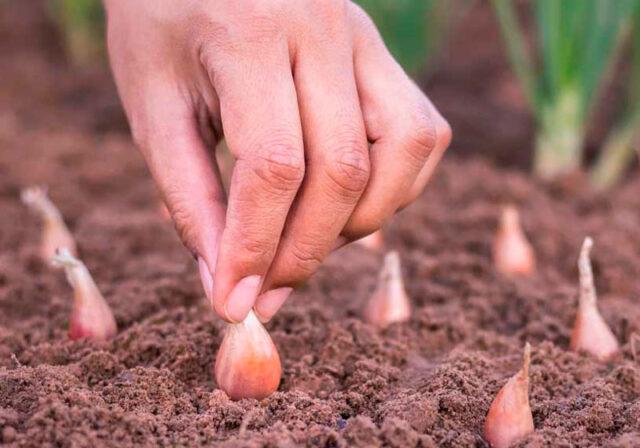
Immerse the bush to such a depth that it sticks out slightly above the ground surface
After sprinkling the seedlings with soil, the area should be mulched.
Caring for Banana Giant onions
Agrotechnical measures that should be carried out in the process of caring for Banana Giant onion plantings:
- Watering is carried out during the dry period, irrigating the beds every seven days. The soil on the site should not dry out or crack. If the summer turns out to be rainy, additional watering will not be required. Three weeks before harvesting, artificial watering is stopped, this will improve the keeping quality of the onion.
- Loosening. At the initial stage of cultivation, it is recommended to loosen the row spacing every week. This will not only saturate the soil with oxygen, allowing onion nests to grow better, but will also prevent weeds from rising up, which can choke out the plantings.
- Fertilizer application. During the growing season, shallots should be fed twice. The first time is after emergence (cow manure or bird droppings are diluted with water in a ratio of 1:10 or 1:15, respectively). The second time - during the formation of the bulbs (40 g of complex mineral fertilizers are dissolved in a bucket of water).
- Disease and pest control. In cold, damp summers, shallots can be affected by fungal diseases. Having noticed an illness, the plant must be removed from the site, and the beds must be treated with a solution of Pentofag, Mikosan or Quadris. Of the parasites, the hybrid can be bothered by onion flies and aphids.For preventive purposes, bushes are treated with saline solution.
Cleaning and storage
Harvesting onions begins after the foliage has dried. This happens at the end of June or beginning of July. If the Banana Giant remains in the ground longer, it will begin to sprout.
During harvesting, the bush is removed from the soil and laid out under a canopy to dry. Then the dry tops are cut off and the nest is disassembled into bulbs.
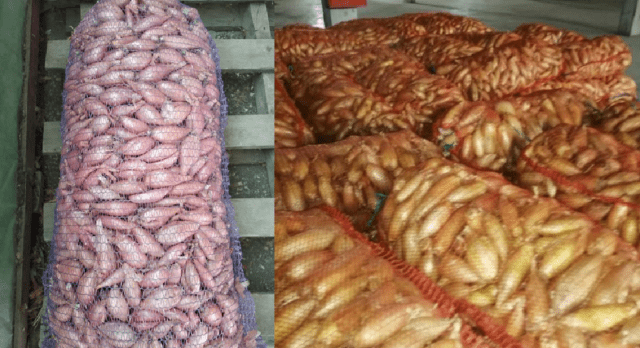
Store the harvest in nets or ventilated boxes in a cool room
Another option for storing shallots is not to trim the leaves, but to weave them into braids. In this case, you need to periodically check the condition of the turnips, removing rotten ones.
Conclusion
Banana Giant onions have gained popularity among gardeners due to their unpretentiousness, universal use, and high yields. The pleasant and piquant taste of the hybrid is noted even by gourmets. It may well replace onion varieties.
Reviews from gardeners about Banana Giant onions
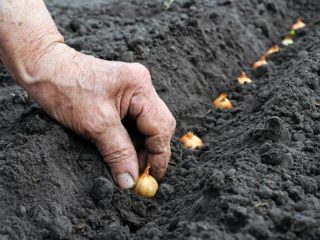



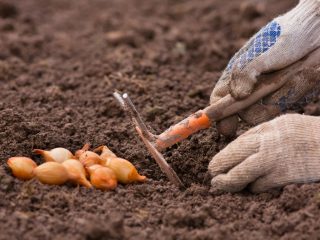

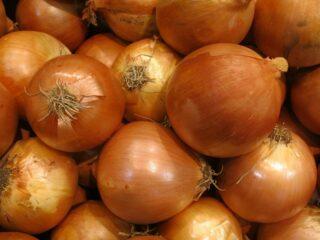

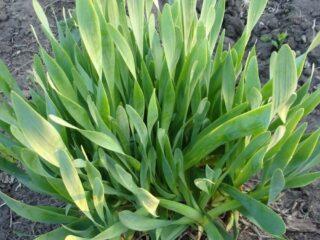
I have been growing banana giant onions for 5 years now and have no regrets, but when I bought 5 of them, the sellers told tales that in one nest there are up to 15 pieces of large onions. Having planted it in the best place, but soon the onion went into arrows from one onion, 3 arrows each, I was not offended, but I collected nigella and I still sow only nigella. Over the summer it grows very large, and we eat the little things green, and so on every year. Very good.
How to distinguish a rockambole from another similar bow